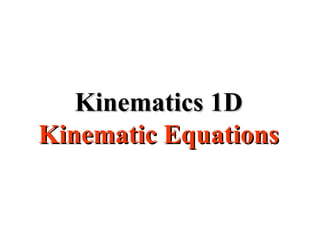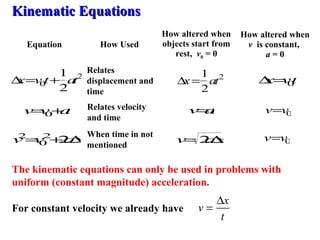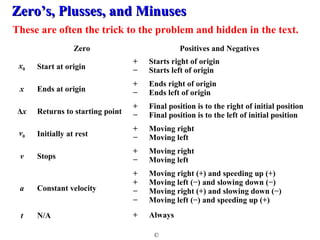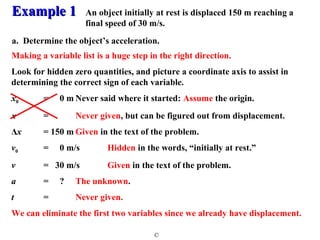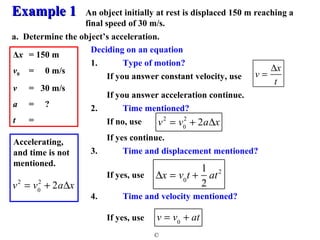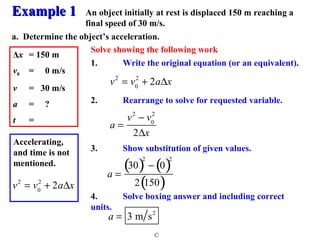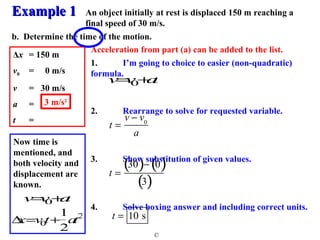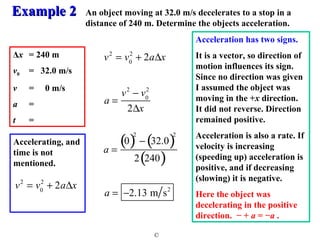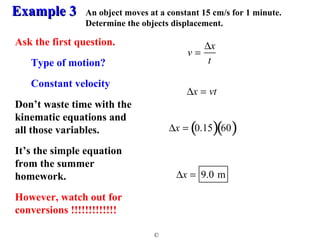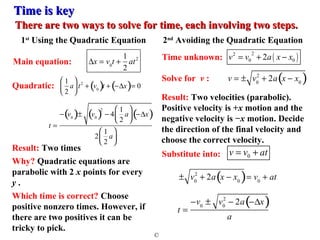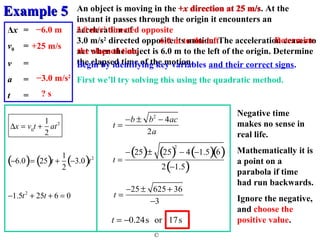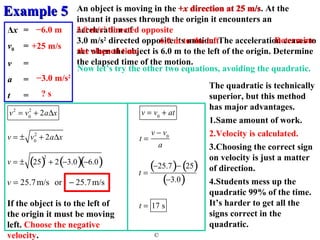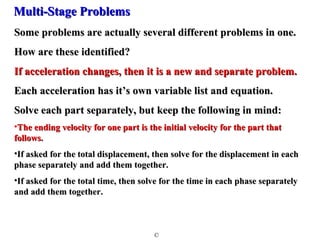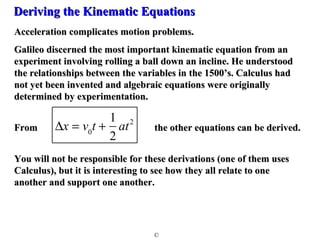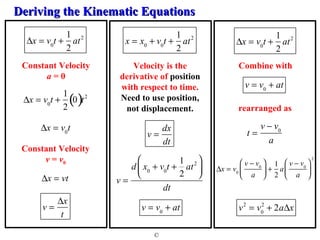Kinematic equations of motion
- 1. KKiinneemmaattiiccss 11DD KKiinneemmaattiicc EEqquuaattiioonnss
- 2. Equation How Used How altered when objects start from rest, v0 = 0 How altered when v is constant, a = 0 KKiinneemmaattiicc EEqquuaattiioonnss 1 2 v=v0+at The kinematic equations can only be used in problems with uniform (constant magnitude) acceleration. For constant velocity we already have v = Dx t Dx=v0t+ at2 v2=v0 2+2aDx ┬Ā Dx= 1 2 at2 ┬Ā v=2aDx ┬Ā v=at ┬Ā Dx=v0t ┬Ā v=v0 ┬Ā v=v0 Relates displacement and time Relates velocity and time When time in not mentioned
- 3. ZZeerrooŌĆÖŌĆÖss,, PPlluusssseess,, aanndd MMiinnuusseess These are often the trick to the problem and hidden in the text. Zero Positives and Negatives x0 Start at origin + Starts right of origin ŌłÆ Starts left of origin x Ends at origin + Ends right of origin ŌłÆ Ends left of origin ╬öx Returns to starting point + Final position is to the right of initial position ŌłÆ Final position is to the left of initial position v0 Initially at rest + Moving right ŌłÆ Moving left v Stops + Moving right ŌłÆ Moving left ┬® a Constant velocity + Moving right (+) and speeding up (+) + Moving left (ŌłÆ) and slowing down (ŌłÆ) ŌłÆ Moving right (+) and slowing down (ŌłÆ) ŌłÆ Moving left (ŌłÆ) and speeding up (+) t N/A + Always
- 4. EExxaammppllee 11 An object initially at rest is displaced 150 m reaching a final speed of 30 m/s. a. Determine the objectŌĆÖs acceleration. Making a variable list is a huge step in the right direction. Look for hidden zero quantities, and picture a coordinate axis to assist in determining the correct sign of each variable. x0 = 0 m Never said where it started: Assume the origin. x = Never given, but can be figured out from displacement. ╬öx = 150 mGiven in the text of the problem. v0 = 0 m/s Hidden in the words, ŌĆ£initially at rest.ŌĆØ v = 30 m/s Given in the text of the problem. a = ? The unknown. t = Never given. We can eliminate the first two variables since we already have displacement. ┬®
- 5. EExxaammppllee 11 An object initially at rest is displaced 150 m reaching a final speed of 30 m/s. a. Determine the objectŌĆÖs acceleration. ╬öx = 150 m v0 = 0 m/s v = 30 m/s a = ? t = Deciding on an equation 1. Type of motion? If you answer constant velocity, use If you answer acceleration continue. 2. Time mentioned? If no, use If yes continue. 3. Time and displacement mentioned? ┬® If yes, use 4. Time and velocity mentioned? If yes, use v = Dx t v2 = v0 2 + 2aDx Dx = v0t + 1 2 at2 v = v0 + at Accelerating, and time is not mentioned. v2 = v0 2 + 2aDx
- 6. EExxaammppllee 11 An object initially at rest is displaced 150 m reaching a final speed of 30 m/s. a. Determine the objectŌĆÖs acceleration. 2 + 2aDx ┬® ╬öx = 150 m v0 = 0 m/s v = 30 m/s a = ? t = Solve showing the following work 1. Write the original equation (or an equivalent). v2 = v0 2. Rearrange to solve for requested variable. 3. Show substitution of given values. 4. Solve boxing answer and including correct units. Accelerating, and time is not mentioned. v2 = v0 2 + 2aDx a = v2 - v0 2 2Dx a = (30)2 - (0)2 2(150) a = 3 m s2
- 7. EExxaammppllee 11 An object initially at rest is displaced 150 m reaching a final speed of 30 m/s. ┬® b. Determine the time of the motion. ╬öx = 150 m v0 = 0 m/s v = 30 m/s a = t = Acceleration from part (a) can be added to the list. 1. IŌĆÖm going to choice to easier (non-quadratic) formula. 2. Rearrange to solve for requested variable. 3. Show substitution of given values. 4. Solve boxing answer and including correct units. ┬Ā Now time is mentioned, and both velocity and displacement are known. t = v - v0 a t = (30)- (0) (3) t = 10 s Dv=v0+at 1 2 x=v0t+ at2 v=v0+at 3 m/s2
- 8. EExxaammppllee 22 An object moving at 32.0 m/s decelerates to a stop in a distance of 240 m. Determine the objects acceleration. ┬® ╬öx = 240 m v= 32.0 m/s 0 v = 0 m/s a = t = Accelerating, and time is not mentioned. v2 = v2 + 2aDx 0 v2 = v0 2 + 2aDx a = v2 - v0 2 2Dx a = (0)2 - (32.0)2 2(240) a = -2.13 m s2 Acceleration has two signs. It is a vector, so direction of motion influences its sign. Since no direction was given I assumed the object was moving in the +x direction. It did not reverse. Direction remained positive. Acceleration is also a rate. If velocity is increasing (speeding up) acceleration is positive, and if decreasing (slowing) it is negative. Here the object was decelerating in the positive direction. ŌłÆ + a = ŌłÆa .
- 9. EExxaammppllee 33 An object moves at a constant 15 cm/s for 1 minute. Determine the objects displacement. ┬® v = Dx t Dx = 9.0 m Ask the first question. Type of motion? Constant velocity DonŌĆÖt waste time with the kinematic equations and all those variables. ItŌĆÖs the simple equation from the summer homework. However, watch out for conversions !!!!!!!!!!!!! Dx = vt Dx = (0.15)(60)
- 10. An object uniformly accelerates from rest reaching a speed v while moving a distance x . Determine its speed when it has moved a distance 2x . Answer in terms of v . No values, but you can still use a variable list. Simply check of any variable mentioned or implied. An object uniformly accelerates check off aa from rest vv00 == 00 reaching a speed v check off vv while moving a distance x check of ╬ö╬öxx How would final speed change if x is doubled to 2x ? Double x in the derived equation and determine the multiplier for v that will maintain the equality. Doubling x increases the right side by root two. Therefore, the left side must also be multiplied by root two. EExxaammppllee 44 ┬® ╬öx = v0 = v = a = t = Accelerating. Time not mentioned. 00 (rreesstt) v2 = v0 2 + 2aDx Substitute v0 = 0 , and rearrange in terms of v . (? v)= 2a(2x) v = 2ax 2v v = 2ax
- 11. TTiimmee iiss kkeeyy TThheerree aarree ttwwoo wwaayyss ttoo ssoollvvee ffoorr ttiimmee,, eeaacchh iinnvvoollvviinngg ttwwoo sstteeppss.. 1st Using the Quadratic Equation 2nd Avoiding the Quadratic Equation ┬® 2 + 2a x - x0 Solve for v : ( ) Result: Two velocities (parabolic). Positive velocity is +x motion and the negative velocity is ŌłÆx motion. Decide the direction of the final velocity and choose the correct velocity. 2 + 2a x - x0 ( )= v0 + at ┬▒ v0 2 2 ( ) 0 0 Time unknown: v = v + 2a x - x v = ┬▒ v0 Dx = v0t + 1 Main equation: at2 2 t = 2 - 2a(-Dx) a -v0 ┬▒ v0 1 2 a ├” ├© ├¦ ├Č ├Ė ├Ę t2 + v0 ( )t + (-Dx)= 0 Quadratic: t = ├” - v0 ( )┬▒ v0 ( )2 - 4 1 2 a ├© ├¦ ├Č ├Ė ├Ę(-Dx) ├” 2 1 2 a ├© ├¦ ├Č ├Ė ├Ę Result: Two times Why? Quadratic equations are parabolic with 2 x points for every y . Which time is correct? Choose positive nonzero times. However, if there are two positives it can be tricky to pick. 0 Substitute into: v = v + at
- 12. EExxaammppllee 55 An object is moving in the +x direction at 25 m/s. At the instant it passes through the origin it encounters an acceleration of 3.0 m/s2 directed opposite its motion. The acceleration ceases to act when the object is 6.0 m to the left of the origin. Determine the elapsed time of the motion. First weŌĆÖll try solving this using the quadratic method. ┬® ╬öx = v0 = v = a = t = 6.0 m to the left Begin by identifying key variables and their correct signs. ŌłÆ6.0 m s +25 m/s 3.0 m/s2 directed opposite ŌłÆ3.0 m/s2 ? s Determine the elapsed time Dx = v0t + 1 2 at2 (-6.0)= (25)t + 1 2 (-3.0)t2 -1.5t2 + 25t + 6 = 0 t = -b ┬▒ b2 - 4ac 2a t = -(25)┬▒ (25)2 - 4(-1.5)(6) 2(-1.5) t = -25 ┬▒ 625 + 36 -3 t = -0.24s or 17s Negative time makes no sense in real life. Mathematically it is a point on a parabola if time had run backwards. Ignore the negative, and choose the positive value.
- 13. EExxaammppllee 55 An object is moving in the +x direction at 25 m/s. At the instant it passes through the origin it encounters an acceleration of 3.0 m/s2 directed opposite its motion. The acceleration ceases to act when the object is 6.0 m to the left of the origin. Determine the elapsed time of the motion. Now letŌĆÖs try the other two equations, avoiding the quadratic. ┬® ╬öx = v0 = v = a = t = 6.0 m to the left ŌłÆ6.0 m s +25 m/s 3.0 m/s2 directed opposite ŌłÆ3.0 m/s2 ? s Determine the elapsed time v2 = v0 2 + 2aDx 2 + 2aDx v = ┬▒ v0 The quadratic is technically superior, but this method has major advantages. 1.Same amount of work. 2.Velocity is calculated. 3.Choosing the correct sign on velocity is just a matter of direction. 4.Students mess up the quadratic 99% of the time. ItŌĆÖs harder to get all the signs correct in the quadratic. v = ┬▒ (25)2 + 2(-3.0)(-6.0) v = 25.7m/s or - 25.7m/s If the object is to the left of the origin it must be moving left. Choose the negative velocity. v = v0 + at t = v - v0 a t = (-25.7)- (25) (-3.0) t = 17 s
- 14. OOfftteenn MMuullttiippllee EEqquuaattiioonnss AArree NNeeeeddeedd OOccccaassiioonnaallllyy yyoouu mmaayy cchhoooossee aann eeqquuaattiioonn tthhaatt sseeeemmss oobbvviioouuss,, bbuutt tthheenn rreeaalliizzee tthhaatt yyoouu aarree mmiissssiinngg iimmppoorrttaanntt vvaarriiaabblleess.. EExxaammppllee:: GGiivveenn vveelloocciittyy ddaattaa yyoouu aarree aasskkeedd ttoo ssoollvvee ffoorr ttiimmee.. ŌĆóYYoouu cchhoossee aann eeqquuaattiioonn ccoonnttaaiinniinngg tthheessee vvaarriiaabblleess.. ŌĆóHHoowweevveerr,, yyoouu rreeaalliizzee tthhaatt yyoouu aarree mmiissssiinngg aacccceelleerraattiioonn.. ŌĆóDDoo nnoott ggiivvee uupp.. TThheerree hhaass ttoo bbee aannootthheerr wwaayy.. ŌĆóTTuurrnn oouutt tthhaatt yyoouu ccaann ssoollvvee:: ŌĆóBBuutt,, hhooww ddooeess tthhiiss hheellpp?? ŌĆóIItt ssoollvveess ffoorr tthhee vvaarriiaabbllee tthhaatt wwaass mmiissssiinngg iinn yyoouurr oorriiggiinnaall eeqquuaattiioonn,, aanndd nnooww yyoouu aarree aabbllee ttoo ssoollvvee ffoorr ttiimmee uussiinngg:: TThhee ppaatthh ttoo tthhee ffiinnaall aannsswweerr iiss nnoott aallwwaayyss oobbvviioouuss,, oorr ddoonnee iinn oonnee sstteepp.. ŌĆ£ŌĆ£SSoollvvee wwhhaatt yyoouu ccaann ssoollvvee,, aanndd kkeeeepp ggooiinngg.. TThhee aannsswweerr wwiillll eevveennttuuaallllyy ttuurrnn uupp..ŌĆØŌĆØ ┬® v = v0 + at v2 = v0 2 + 2aDx v = v0 + at
- 15. MMuullttii--SSttaaggee PPrroobblleemmss SSoommee pprroobblleemmss aarree aaccttuuaallllyy sseevveerraall ddiiffffeerreenntt pprroobblleemmss iinn oonnee.. HHooww aarree tthheessee iiddeennttiiffiieedd?? IIff aacccceelleerraattiioonn cchhaannggeess,, tthheenn iitt iiss aa nneeww aanndd sseeppaarraattee pprroobblleemm.. EEaacchh aacccceelleerraattiioonn hhaass iittŌĆÖŌĆÖss oowwnn vvaarriiaabbllee lliisstt aanndd eeqquuaattiioonn.. SSoollvvee eeaacchh ppaarrtt sseeppaarraatteellyy,, bbuutt kkeeeepp tthhee ffoolllloowwiinngg iinn mmiinndd:: ŌĆóTThhee eennddiinngg vveelloocciittyy ffoorr oonnee ppaarrtt iiss tthhee iinniittiiaall vveelloocciittyy ffoorr tthhee ppaarrtt tthhaatt ffoolllloowwss.. ŌĆóIIff aasskkeedd ffoorr tthhee ttoottaall ddiissppllaacceemmeenntt,, tthheenn ssoollvvee ffoorr tthhee ddiissppllaacceemmeenntt iinn eeaacchh pphhaassee sseeppaarraatteellyy aanndd aadddd tthheemm ttooggeetthheerr.. ŌĆóIIff aasskkeedd ffoorr tthhee ttoottaall ttiimmee,, tthheenn ssoollvvee ffoorr tthhee ttiimmee iinn eeaacchh pphhaassee sseeppaarraatteellyy aanndd aadddd tthheemm ttooggeetthheerr.. ┬®
- 16. EExxaammppllee 66 This problem has three distinct parts, with three different accelerations ŌĆ£constant velocityŌĆØ ŌĆ£slows to a stopŌĆØ 800 m 180 m ┬® Finally the car slows to a stop in a distance of 180 m. ╬öx = v0 = v = a = t = ╬öx = v0 = v = a = t = ŌĆ£ 2.4 m/s2 ŌĆØ ╬öx = v0 = v = a = t = A car is at rest at a traffic signal. When the light turns green the car accelerates at 2.4 m/s2 for 15 s. 0 m/s 2.4 m/s2 Then the driver maintains a constant velocity for 0.80 km. 0 m/s2 15 s ŌłÆ? m/s2 What other variables can be discerned from the problem above? Are there any important facts we should keep in mind? 0 m/s The final velocity of one phase becomes the initial velocity for the next. Constant velocity means that initial and final velocities are equal.
- 17. A car is at rest at a traffic signal. When the light turns green the car accelerates at 2.4 m/s2 for 15 s. Then the driver maintains a constant velocity for 0.80 km. Finally the car slows to a stop in a distance of 180 m. 800 m 180 m ŌłÆ? m/s2 EExxaammppllee 66 ŌłÆ3.6 m/s2 ╬öx = v0 = v = a = t = 22 s 10 s Constant Velocity Equation ┬® 0 m/s 36 m/s v = v0 + at v = (0)+ (2.4)(15) v = 36m s 36 m/s 36 m/s 36 m/s Dx = v0t + 1 2 at2 Dx = (0)(15)+ 1 2 (2.4)(15)2 Dx = 270m 270 m v = Dx t (36)= (800) t t = 22m s v2 = v0 2 + 2aDx (0)2 = (36)2 + 2a(180) a = -3.6m s2 v = v0 + at (0)= (36)+ (-3.6)t t = 10s ╬öx = v0 = v = a = t = ╬öx = v0 = v = a = t = 2.4 m/s2 0 m/s2 15 s 0 m/s
- 18. A car is at rest at a traffic signal. When the light turns green the car accelerates at 2.4 m/s2 for 15 s. Then the driver maintains a constant velocity for 0.80 km. Finally the car slows to a stop in a distance of 180 m. 800 m 180 m ŌłÆ? m/s2 EExxaammppllee 66 ttotal = t1 + t2 + t3 = (15)+ (22)+ (10)= 47 s ┬® 0 m/s 36 m/s 36 m/s 36 m/s 36 m/s 270 m ŌłÆ3.6 m/s2 ╬öx = v0 = v = a = t = 22 s 10 s ╬öx = v0 = v = a = t = ╬öx = v0 = v = a = t = 2.4 m/s2 0 m/s2 15 s 0 m/s To find the total time sum the times of all three phases. To find the total displacement sum the displacements of all three phases. Dxtotal = Dx1 + Dx2 + Dx3 = (270)+ (800)+ (180)= 1250m
- 19. DDeerriivviinngg tthhee KKiinneemmaattiicc EEqquuaattiioonnss AAcccceelleerraattiioonn ccoommpplliiccaatteess mmoottiioonn pprroobblleemmss.. GGaalliilleeoo ddiisscceerrnneedd tthhee mmoosstt iimmppoorrttaanntt kkiinneemmaattiicc eeqquuaattiioonn ffrroomm aann eexxppeerriimmeenntt iinnvvoollvviinngg rroolllliinngg aa bbaallll ddoowwnn aann iinncclliinnee.. HHee uunnddeerrssttoooodd tthhee rreellaattiioonnsshhiippss bbeettwweeeenn tthhee vvaarriiaabblleess iinn tthhee 11550000ŌĆÖŌĆÖss.. CCaallccuulluuss hhaadd nnoott yyeett bbeeeenn iinnvveenntteedd aanndd aallggeebbrraaiicc eeqquuaattiioonnss wweerree oorriiggiinnaallllyy ddeetteerrmmiinneedd bbyy eexxppeerriimmeennttaattiioonn.. FFrroomm tthhee ootthheerr eeqquuaattiioonnss ccaann bbee ddeerriivveedd.. YYoouu wwiillll nnoott bbee rreessppoonnssiibbllee ffoorr tthheessee ddeerriivvaattiioonnss ((oonnee ooff tthheemm uusseess CCaallccuulluuss)),, bbuutt iitt iiss iinntteerreessttiinngg ttoo sseeee hhooww tthheeyy aallll rreellaattee ttoo oonnee aannootthheerr aanndd ssuuppppoorrtt oonnee aannootthheerr.. ┬® Dx = v0t + 1 2 at2
- 20. DDeerriivviinngg tthhee KKiinneemmaattiicc EEqquuaattiioonnss at2 ├” ┬® Dx = v0t + 1 2 at2 x = x0 + v0t + 1 2 at2 Dx = v0t + 1 2 at2 Constant Velocity a = 0 Dx = v0t + 1 2 (0)t2 Dx = v0t Constant Velocity v = v0 Dx = vt v = Dx t Velocity is the derivative of position with respect to time. Need to use position, not displacement. v = dx dt v = d x0 + v0t + 1 2 ├© ├¦ ├Č ├Ė ├Ę dt v = v0 + at Combine with v = v0 + at rearranged as t = v - v0 a Dx = v0 v - v0 a ├” ├© ├¦ ├Č ├Ė ├Ę + 1 2 a v - v0 a ├” ├© ├¦ ├Č ├Ė ├Ę 2 v2 = v0 2 + 2aDx
